“written by Dr. Maren Engelhardt for Trakehners International”
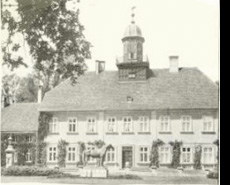 The Trakehner horse is the oldest warmblood breed in the world, with a history spanning over 400 years. The official name, “The East Prussian Warmblood Horse of Trakehner Origin” hints to the roots of this magnificent breed: the region of East Prussia once belonging to Germany, but lost during World War II to Russia.
The Trakehner horse is the oldest warmblood breed in the world, with a history spanning over 400 years. The official name, “The East Prussian Warmblood Horse of Trakehner Origin” hints to the roots of this magnificent breed: the region of East Prussia once belonging to Germany, but lost during World War II to Russia.
The origin of the breed is a small horse – bred locally in East Prussia – known as the “Schwaike”. The Schwaike was known for its versatility and endurance. When this breed was crossed with imported English thoroughbred and Arabian stallions, the resulting horse was named after the main stud it came from: Trakehnen. The original purpose of the Trakehner was for use as calvary mount.
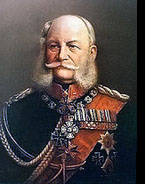 In the early 18th century, King Friedrich Wilhelm I realized that a new type of cavalry mount was needed as war tactics had changed and demanded a faster, lighter horse that also posessed power & endurance. In 1732, he moved the best of his cavalry horses to the new royal stud farm Trakehnen and began to systematically breed a horse that would meet many criteria. The new cavalry mounts had to be attractive enough to be a representative horse for his officers but additionally had to be tough enough to survive hard situations and come out sound.
In the early 18th century, King Friedrich Wilhelm I realized that a new type of cavalry mount was needed as war tactics had changed and demanded a faster, lighter horse that also posessed power & endurance. In 1732, he moved the best of his cavalry horses to the new royal stud farm Trakehnen and began to systematically breed a horse that would meet many criteria. The new cavalry mounts had to be attractive enough to be a representative horse for his officers but additionally had to be tough enough to survive hard situations and come out sound. Through his efforts, the Trakehner breed evolved. At the same time, East Prussian framers were breeding the same base of horses. East Prussia therefore had two separate, but equally outstanding sources for riding horses. The military & civilian herds were mixed often, further consolidating the best possible traits.
Through his efforts, the Trakehner breed evolved. At the same time, East Prussian framers were breeding the same base of horses. East Prussia therefore had two separate, but equally outstanding sources for riding horses. The military & civilian herds were mixed often, further consolidating the best possible traits.
 The main stud Trakehnen was a huge compound, a city of its own, covering some 15.000 acres. Apart from the main complex, sixteen “Vorwerke” (more distant barns) were home to the famous mare herds. The Trakehner horse was bred depending on its color; which may sound strange but made perfect sense once one takes into consideration that the differently colored herds also showed certain traits that were useful for the population. The black herd at Gurdzen for example consisted of mares that had the most substance and were very strong and outstanding “workers”. Famous stallions like Ararad and Jagdheld were crossed with these mares, mainly to maintain a balance to the otherwise very refined Trakehners. Even today, these “heaviers” genes can come through in the descendants of this great herd.
The main stud Trakehnen was a huge compound, a city of its own, covering some 15.000 acres. Apart from the main complex, sixteen “Vorwerke” (more distant barns) were home to the famous mare herds. The Trakehner horse was bred depending on its color; which may sound strange but made perfect sense once one takes into consideration that the differently colored herds also showed certain traits that were useful for the population. The black herd at Gurdzen for example consisted of mares that had the most substance and were very strong and outstanding “workers”. Famous stallions like Ararad and Jagdheld were crossed with these mares, mainly to maintain a balance to the otherwise very refined Trakehners. Even today, these “heaviers” genes can come through in the descendants of this great herd.
 The chestnut mares were collected at Trakehnen itself. Descending from famous thoroughbreds like Thunderclap xx, the chestnut mares were elegant, sensitive and exhibited the greatest performance potential. One of the most successful dressage lines of all times in warmblood breeding, the Hanovarian A-line, founded by the Trakehner stallion Abglanz, originated from the chestnut herd.
The chestnut mares were collected at Trakehnen itself. Descending from famous thoroughbreds like Thunderclap xx, the chestnut mares were elegant, sensitive and exhibited the greatest performance potential. One of the most successful dressage lines of all times in warmblood breeding, the Hanovarian A-line, founded by the Trakehner stallion Abglanz, originated from the chestnut herd.
Bay and brown mares were collected at Kalpakin. They were known for outstanding temperament and again, excellent rideability. And at Bajorgallen, the “mixed herd” was stationed. Here mares of all colors including the gray horses were bred to many of the Arabian stallions. Foundation mares like Kassette and Donna came out of that exquisite group of horses and even today, 60 years after their time are the most prominent names in the history of Trakehner horses. A chief sire at Trakehnen lived like a king. Each stallion had a huge paddock that was fenced by trees and bushes. The stall was a stone house, open to one side, built like a round pen with a luxury roof and beautiful steel ornaments. Each stallion was assigned a private groom, always older and proven men that had spent their lives at Trakehnen and had that special “6th horse sense” built in.
It must have been a special view each morning when the men opened the giant barn doors at Trakehnen and waves of gleaming horses made their way along the paths to the pastures. There were no fences at Trakehnen, the horses were guarded by a man on a horse, watching over “his” friends every day.
Weanlings were kept in large herds and had all the freedom a young horse could dream of. At three years old colts were started under saddle and thoroughly tested to determine their future: cavalry, riding horse or future sire for Trakehnen and the East Prussian local studs. Obviously with so many high quality horses, only the very best were chosen as potential future sires. These – the cream of the crop – next underwent the stallion performance test. Performance testing lasted a full year and was held at Zwion, the state’s stallion test station and the first of its kind in the world. The colts were driven, raced, used for hard fox hunting and eventing, trained in dressage and tested over jumps. All colts were evaluated thoroughly on character, rideability and temperament. Only the very best of these magnificent animals were chosen to contribute to the prestigious gene pool at Trakehnen.
By far more mares were distributed among the smaller breeding farms of the East Prussian farmers than at Trakehnen. This resulted in an indigenous breed, which was the great advantage of the East Prussian as opposed to other breeds, since it made for a great consistency. Their quality improved as Trakehnen and the bigger private studs raised a large number of their foals. The state stallion depots and the riding and driving clubs formed their backbone. At local and national shows, they competed with larger breeders.
But Trakehnen was much more than horses and people, operating one of East Prussia’s biggest agricultural farms with 900 cows, 600 sheep and other farm animals. At this agricultural farm, a stock of 500 Trakehner horses was only used for farm work.
 With the addition of English and Arabian thoroughbreds the Trakehner achieved the great beauty, legendary soundness as well as the wonderful floating way of going and great jumping abilities that makes the Trakehner horse world-famous. Today, quality Thoroughbred and Arabian horses are allowed into the otherwise closed studbook. This consistency of breeding helps maintain the “Trakehner look”, “freshens” the bloodlines and adds great rideability and sensitivity.
With the addition of English and Arabian thoroughbreds the Trakehner achieved the great beauty, legendary soundness as well as the wonderful floating way of going and great jumping abilities that makes the Trakehner horse world-famous. Today, quality Thoroughbred and Arabian horses are allowed into the otherwise closed studbook. This consistency of breeding helps maintain the “Trakehner look”, “freshens” the bloodlines and adds great rideability and sensitivity.
The Trakehner horse was the most successful sport horse in the world between the two World Wars. Olympic gold in dressage went to Piccolomini in 1924, and the silver medal went to Sabel. In 1936, the dressage gold medal was won by the 7-year old Kronos, the gold medal in eventing was won by the Trakehner Nurmi and the winning German eventing team was made up of two Trakehners and one Thoroughbred.
The East Prussian warmblood horse was exported not only to Europe but all over the world. In 1938 some 478.000 horses lived in East Prussia with 1.289 stallions covering 89.628 East Prussian mares. Trakehners were used for all purposes: hard-working farm horses in the fields, courageous & sound cavalry mounts, for fox hunting, driving and last but not least for horse racing. Between 1921 and 1936, the hardest steeplechase in the world, the Pardubice steeplechase, was won 9 times by East Prussian horses.
Dominant influential sire lines
Over the years, such careful breeding & selection of breeding stallions created some legendary sire lines. These Chief Sires had a dominant influence on East Prussian breeding, which is still felt today.
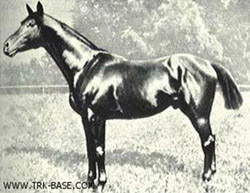 Perfectionist xx: 1899 foaled in UK, chief sire in Trakehnen 1904-1906. He was most influential through his sons Tempelhüter, Jagdheld, Irrlehrer, and his daughter, Posthalterin, dam of the foundation sire Parsival.
Perfectionist xx: 1899 foaled in UK, chief sire in Trakehnen 1904-1906. He was most influential through his sons Tempelhüter, Jagdheld, Irrlehrer, and his daughter, Posthalterin, dam of the foundation sire Parsival.
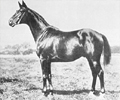 Tempelhüter: Chief sire in Trakehnen 1916-1931. At that time, considered the perfect example of the Trakehner. As illustration of his unrivaled significance, a statue of this magnificent stallion was erected in front of the State Stud at Trakehnen where it remained until being taken as war booty to Russia after World War II.
Tempelhüter: Chief sire in Trakehnen 1916-1931. At that time, considered the perfect example of the Trakehner. As illustration of his unrivaled significance, a statue of this magnificent stallion was erected in front of the State Stud at Trakehnen where it remained until being taken as war booty to Russia after World War II.
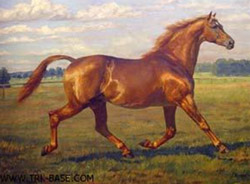 Dampfross: His line is still very popular today, with many leading Trakehner stallions representing his bloodline.
Dampfross: His line is still very popular today, with many leading Trakehner stallions representing his bloodline.
Pythagoras: by Dampfroß out of Pechmarie by Tempelhüter. Chief sire 1933-1944. Combining the blood of the two “Century Sires” Dampfross and Tempelhüter, Pythagoras was Trakehnen’s leading sire prior to WWII. His son Totilas and daughter Tapete were instrumental in revitalizing the breed after the war.
Cancara: Representing the idea of combining Arabian and English TB, Cancara was one of Trakehnen’s leading sport horse producers. His daughters Donna and Kokette are among the most prominent Trakehner mares of all times.
Fetysz ox: Fetysz is the foundation stallion of today’s best dressage lines in the Trakehner breed. Tragically shot by the invading Russian Army, Feytsz ox nevertheless left his legacy as even Olympic competitors today carry his valuable blood. Harun al Raschid: He influenced the breed especially through his outstanding daughters, most importantly the famous Kassette. 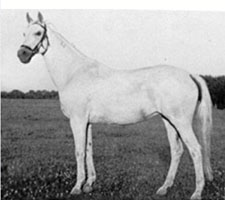 The blood of Kassette continues to amaze all over the world, from Australia’s former event champion Kassiber to the latest Trakehner champion stallion of 2001: K2, the quality of the Kassette line cannot be denied.
The blood of Kassette continues to amaze all over the world, from Australia’s former event champion Kassiber to the latest Trakehner champion stallion of 2001: K2, the quality of the Kassette line cannot be denied.
War and Trek
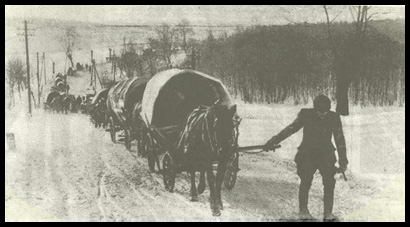 During World War I, the population of the Trakehner horse was halved and it took great efforts of the breeders to bring the breed back to its former numbers and famous standard of quality. But in 1944, in the closing days of WWII, it seemed these heroic efforts would have been in vain.
During World War I, the population of the Trakehner horse was halved and it took great efforts of the breeders to bring the breed back to its former numbers and famous standard of quality. But in 1944, in the closing days of WWII, it seemed these heroic efforts would have been in vain.
In the harsh winter, as the Russian Army broke across the front lines and invaded East Prussia, people were forced to leave their land and belongings behind to save not much more than their lives. In October 1944 it was decided to evacuate the main stud Trakehnen. A total of 800 of the best mares, stallions and young colts were loaded on trains and driven to the West. Most of these horses were lost to the Russians.
The private breeders and their horses were not allowed to leave until January of 1945, when there was almost no time to escape. In the terrible and cold winter, the “Trek” began; a gathering of tens of thousands of people and some 18.000 East Prussian horses bundled their most precious belongings in wagons and began walking and driving westbound. Mares were heavy in foal and sometimes there wasn’t food for days. Thousands of lives were lost, horses that wouldn’t make it any further had to be left behind, the horror of these months is hard to describe in words. Eventually, most East Prussians reached the safety of the West, but at a terrible price. By the end of World War II, Trakehnen was no more. This “Horse Pardise”, once a virtual “City of Horses” was laid to waste, and only a handful of Trakehner horses survived the horrific performance test that forever after would be referred to in hushed tones as “The Trek”. From the legendary, great mare herds of Trakehnen – once grouped by color – only the strongest survived . . a mere 21 original main stud mares.
Trakehnen and its horses seemed to have been lost forever. It is only because of a few dedicated individuals, totally committed to saving this great treasure, that today the Trakehner is not a footnote in history. The most important stallions were lost during the trek. Some – like Feytsz ox – were shot by the army, others were captured and taken to Kirov, where they established one of today’s most powerful sport horses, the Russian Trakehner.
A new beginning
 Of the 1.100 once beautiful and proud horses from the main stud Trakehnen, only around 100 individuals survived, many with tremendous injuries. Additionally, the East Prussian horses that belonged to the private breeders and had made the trek were scattered all over what remained of Germany. The following years were spent trying to relocate and collect and catalog these few Trakehners. In October 1947, the “West German Association of Breeders and Friends of the Warmblood Horse of Trakehner Origin”, today known as the “Trakehner Verband”, was established, replacing the East Prussian Stud Book Society. Together with the Trakehner horses of private breeders from East Prussia, a few hundred Trakehners were available for rebuilding the breed.
Of the 1.100 once beautiful and proud horses from the main stud Trakehnen, only around 100 individuals survived, many with tremendous injuries. Additionally, the East Prussian horses that belonged to the private breeders and had made the trek were scattered all over what remained of Germany. The following years were spent trying to relocate and collect and catalog these few Trakehners. In October 1947, the “West German Association of Breeders and Friends of the Warmblood Horse of Trakehner Origin”, today known as the “Trakehner Verband”, was established, replacing the East Prussian Stud Book Society. Together with the Trakehner horses of private breeders from East Prussia, a few hundred Trakehners were available for rebuilding the breed.
The Verband’s first president, Baron von Schrötter and his manager, Dr. Fritz Schilke, spent most of their time in the years following the war finding and relocating the horses. In 1950, the state government of Lower Saxony and the German government stepped in to help, providing the Trakehner Verband with a central breeding facility in Hunnesrück, Lower Saxony. Together with the Trakehner stud farms Rantzau and Schmoel, Hunnesrück soon became famous. The last original Trakehner brood mares from the main stud were collected here and used to breed future generations. Great foundation mares like Kassette, Polarfahrt, Donna, Tapete, Halensee and others found a last home in these Trakehner farms, together with some of the last sires rescued from the main stud, like the Pythagoras-son Totilas, who was most important to establish the Trakehner breed in West Germany. Smaller private breeders were given the opportunity to board their mares there, the resulting foals belonged to the “Trakehner Gesellschaft”, a corporation founded to preserve and promote the Trakehner in West Germany and later the whole world.
In the former German Democratic Republic (GDR), the situation was much the same. After the Soviet forces had closed the borders, the Trakehner horses that were stranded in the GDR were scattered all around the country and again, Trakehner lovers and enthusiasts, many of them East Prussian breeders that had lost everything, started to collect and breed these horses and maintained a high quality Trakehner population until the reunification of Germany in 1991, when not only the wall came down and Germany grew together again, but when also this fine breed was unified.
It was due to yet another outstanding personality, Dietrich von Lenski, who originated in one East Prussia’s biggest private stud farms, Kattenau, that the “Trakehner Förderverein” was established. The Förderverein is an organization that helps to promote the Trakehner in the international sport world by providing exceptional horses to internationally successful riders. Also, young talents are spotted and the owners are funded to maintain a high training standard for these horses.
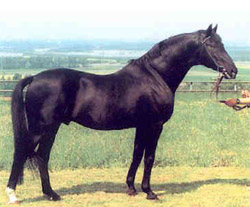 The most prominent example of such a Förderverein-owned horse was the black Trakehner stallion
The most prominent example of such a Förderverein-owned horse was the black Trakehner stallion 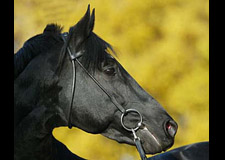 Habicht (by Burnus AAH out of Hallo, by Goldregen). Habicht was given to the Trakehner Verband stud at Hunnesrück for breeding purposes and yet, at the same time, the Förderverein provided the young German rider Martin Plewa with this incredible stallion. The results on both sides were outstanding: Habicht won the international CCI*** at Achselschwang and also established a famous stallion line, today represented for example by his elite son Sixtus (out of Stradelle by Ibikus) and the German premium stallion Windfall.
Habicht (by Burnus AAH out of Hallo, by Goldregen). Habicht was given to the Trakehner Verband stud at Hunnesrück for breeding purposes and yet, at the same time, the Förderverein provided the young German rider Martin Plewa with this incredible stallion. The results on both sides were outstanding: Habicht won the international CCI*** at Achselschwang and also established a famous stallion line, today represented for example by his elite son Sixtus (out of Stradelle by Ibikus) and the German premium stallion Windfall.
In the 1980s, the Trakehner Verband owned three breeding operations: Hunnesrück, Rantzau and Birkhausen, a wonderful farm in the state of Rhineland-Palatinate. From stud Birkhausen, the Trakehner conquered the world. It was in Birkhausen that in 1970 the gray mare Abiza was covered by the bay stallion, Donauwind. She exported in foal to Canada and the resulting colt later became the internationally famous Abdullah. In addition to Birkhausen, several private breeders established new breeding farms, some of them gaining world stature. Webelsgrund for example, founded by Fritz Bähre in the 1950s, was home to the legendary sire Impuls. 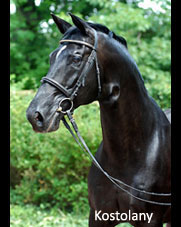 Also, Hämelschenburg of the Langels family in Emmerthal must be mentioned here, they provided several high studbook and elite mares and outstanding stallions like Kostolany.
Also, Hämelschenburg of the Langels family in Emmerthal must be mentioned here, they provided several high studbook and elite mares and outstanding stallions like Kostolany. 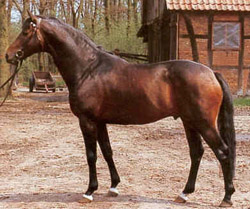 Gottfried Hoogen’s Vogelsangshof was the origin of the best Trakehner dressage sire of all times, Mahagoni, who later moved to yet another famous farm, Hörem of Hubertus Poll, who in later years stood such incredible individuals as Consul, Rockefeller and today, Buddenbrock. And of course Hörstein, founded by Adam Dreßler in 1962 and today run by his daughter Christa and her husband Wolfgang Diehm always stood out, both nationally and internationally, and was Habicht’s home for many years. Hörstein also has to be named as one of Germany’s top event horse breeding farms. National and International competitors like Sixtus, Grand Prix, Starway and Windfall came from Hörstein.
Gottfried Hoogen’s Vogelsangshof was the origin of the best Trakehner dressage sire of all times, Mahagoni, who later moved to yet another famous farm, Hörem of Hubertus Poll, who in later years stood such incredible individuals as Consul, Rockefeller and today, Buddenbrock. And of course Hörstein, founded by Adam Dreßler in 1962 and today run by his daughter Christa and her husband Wolfgang Diehm always stood out, both nationally and internationally, and was Habicht’s home for many years. Hörstein also has to be named as one of Germany’s top event horse breeding farms. National and International competitors like Sixtus, Grand Prix, Starway and Windfall came from Hörstein.
* This information was originally posted at www.trakehners-international.com *



